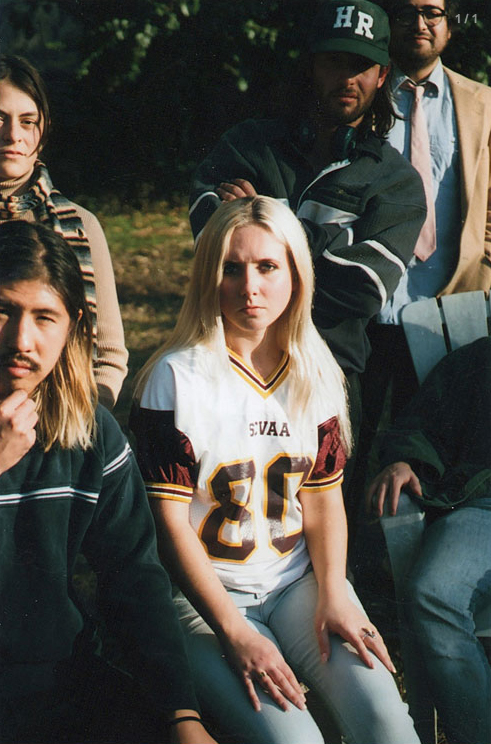Q&A: Art alumnus talks exhibition inspired by MTV’s ‘Scream’

Art alumnus Phil Davis created the artwork for the exhibit “MTV2” by photographing and then creating paintings of his friends and actors as they read a script he wrote based on a high school murder mystery. One example is “Promotional Photo (Group)” seen here. (Courtesy of Phil Davis)
By Olivia Mazzucato
Jan. 30, 2017 9:33 p.m.
All of Phil Davis’ ideas flew out the window when Night Gallery invited him to put on a solo exhibition.
It wasn’t until he came across the Instagram account for MTV’s TV show “Scream” that he had a clear idea for an art show – a high school murder mystery. He then used this story archetype to explore the way people process and interpret mundane tropes, using a layering of different mediums.
With a clear concept in mind, the 2012 art alumnus wrote a play, his own version of “Scream.” He assembled a cast of friends and professional actors to read the script and he photographed them throughout the process of rehearsing in his studio.
He created a series of oil paintings from the photographs, which served to subvert the genre by showcasing the material through a more traditional medium. All three art forms – script, photos and paintings – are part of an exhibition titled “MTV2,”which opened Friday and will run until March 4 at Night Gallery in Los Angeles.
[Related: Q&A: ‘The Beauty in You’ art gallery aims to foster body positivity]
The Daily Bruin’s Olivia Mazzucato spoke with Davis about the artifice of acting, his creative process and the importance of being critical of everyday images.
Daily Bruin: What inspired “MTV2”?
Phil Davis: I’m interested in how people interpret the commonplace gestures, poses and archetypal figures that they absorb everyday from television, media and advertising …
And then further, instead of translating those images into what we’re used to seeing, like a bus ad or billboard or an Instagram for some actor, what happens if you make an oil painting out of that? An oil painting is very slow, very carefully made. Slow is really the main important thing here, because instead of … really fast, immediate, spitting it out, it’s interpreting something like that into a classical medium like painting, slowly built up with layers of pigment on linen.
DB: How did you choose these three different types of mediums to show in the exhibit?
PD: There’s a system set up, where first there’s a script. First there’s the interest in writing what a troped scenario, what a really commonplace thing is. The jury’s out on that if people find a high school murder mystery as commonplace and hackneyed as I do. But I chose that, so I’m going to write this script.
I don’t consider myself a painter, but I make these paintings that come out of this system that I’ve set up and those are what came out of the structure that I had set up for myself.
DB: This is a very conceptual piece. How does this compare to your previous projects?
PD: It’s always like a system that I set up. Sometimes paintings come out of that, sometimes photos, sometimes videos, sometimes sculptures, sometimes performance, so it’s consistent insofar that it’s part of that system.
It’s all kind of inconsistent, but it’s consistently versatile and different. … (It’s) approaching overlooked and commonplace aesthetic phenomenon and how we, as a people, interact with those images and how we take them in and put them back out. But this has been the most focused on that concept.
[Related: Kerckhoff Art Gallery showcases work of LGBTQ and disabled community]
DB: You cast a mixture of your friends and professional actors in the project. How did having that range of people impact your project?
PD: You can see some people are breaking character and laughing or get embarrassed or won’t look up from their script. Other people are completely just stone-cold in character. Some people are somewhere in between. Some people are overacting and some people aren’t. There’s no theatrical failure in my studio, it’s all just recording that spectrum of artifice.
DB: How did your time at UCLA influence you as an artist?
PD: Immensely, but the bottom line was that it exposed me to the deeper, more thoughtful way of looking at art. … (I realized) I could be whatever kind of artist I need to be and inherently in that profession is a commitment to not conforming to a particular dogmatic thing. It’s forging your own path to some degree. Most of all, it introduced me to really awesome people, my fellow students and people I still work on projects with.
DB: What do you hope people take away from the exhibit?
PD: I mean, that’s not up to me. I guess I hope people can consider for a moment how they might deal with seemingly basic imagery and are constantly critical about things, as opposed to letting things float over them …
We let things pass by and I think we must remain critical of what is put in front of us, no matter how commonplace it is, because those are the things that are actually the most intrinsic and common in the world. Those things, even if we get sick of looking at them, they’re kind of what matters because they’re everywhere.

